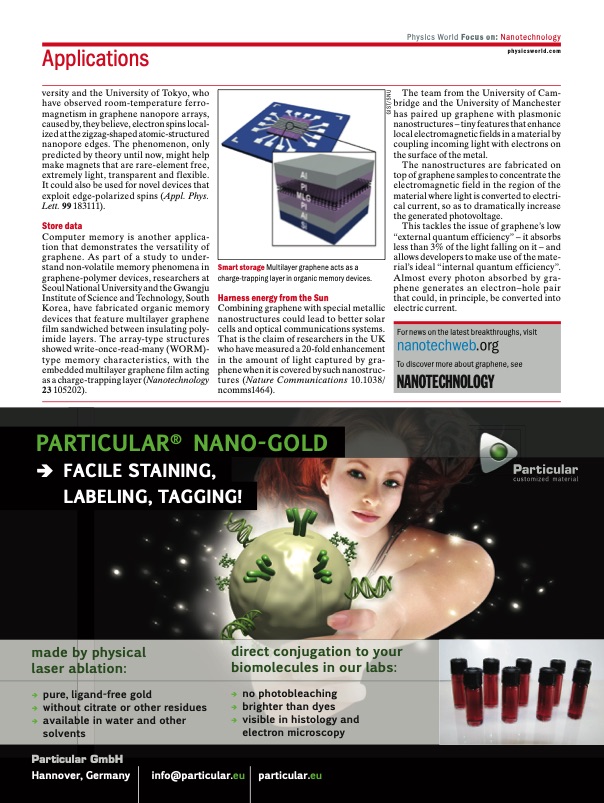
PDF Publication Title:
Text from PDF Page: 004
Applications versity and the University of Tokyo, who have observed room-temperature ferro- magnetism in graphene nanopore arrays, caused by, they believe, electron spins local- ized at the zigzag-shaped atomic-structured nanopore edges. The phenomenon, only predicted by theory until now, might help make magnets that are rare-element free, extremely light, transparent and flexible. It could also be used for novel devices that exploit edge-polarized spins (Appl. Phys. Lett. 99 183111). Store data Computer memory is another applica- tion that demonstrates the versatility of graphene. As part of a study to under- stand non-volatile memory phenomena in graphene-polymer devices, researchers at Seoul National University and the Gwangju Institute of Science and Technology, South Korea, have fabricated organic memory devices that feature multilayer graphene film sandwiched between insulating poly- imide layers. The array-type structures showed write-once-read-many (WORM)- type memory characteristics, with the embedded multilayer graphene film acting as a charge-trapping layer (Nanotechnology 23 105202). Smart storage Multilayer graphene acts as a charge-trapping layer in organic memory devices. Harness energy from the Sun Combining graphene with special metallic nanostructures could lead to better solar cells and optical communications systems. That is the claim of researchers in the UK who have measured a 20-fold enhancement in the amount of light captured by gra- phene when it is covered by such nanostruc- tures (Nature Communications 10.1038/ ncomms1464). Physics World Focus on: Nanotechnology physicsworld.com The team from the University of Cam- bridge and the University of Manchester has paired up graphene with plasmonic nanostructures – tiny features that enhance local electromagnetic fields in a material by coupling incoming light with electrons on the surface of the metal. The nanostructures are fabricated on top of graphene samples to concentrate the electromagnetic field in the region of the material where light is converted to electri- cal current, so as to dramatically increase the generated photovoltage. This tackles the issue of graphene’s low “external quantum efficiency” – it absorbs less than 3% of the light falling on it – and allows developers to make use of the mate- rial’s ideal “internal quantum efficiency”. Almost every photon absorbed by gra- phene generates an electron–hole pair that could, in principle, be converted into electric current. GIST/SNU FACILE STAINING, made by physical laser ablation: Îpure, ligand-free gold Îwithout citrate or other residues Îavailable in water and other solvents Particular GmbH direct conjugation to your biomolecules in our labs: Îno photobleaching Îbrighter than dyes Îvisible in histology and electron microscopy For news on the latest breakthroughs, visit To discover more about graphene, see NANOTECHNOLOGY PARTICULAR® NANO-GOLD LABELING, TAGGING! Hannover, Germany info@particular.eu particular.eu PWNANOJun12Graphene.indd 14 15/05/2012 10:16PDF Image | Graphene for Solid State Physics II

PDF Search Title:
Graphene for Solid State Physics IIOriginal File Name Searched:
graphene.pdfDIY PDF Search: Google It | Yahoo | Bing
Salgenx Redox Flow Battery Technology: Power up your energy storage game with Salgenx Salt Water Battery. With its advanced technology, the flow battery provides reliable, scalable, and sustainable energy storage for utility-scale projects. Upgrade to a Salgenx flow battery today and take control of your energy future.
| CONTACT TEL: 608-238-6001 Email: greg@infinityturbine.com | RSS | AMP |